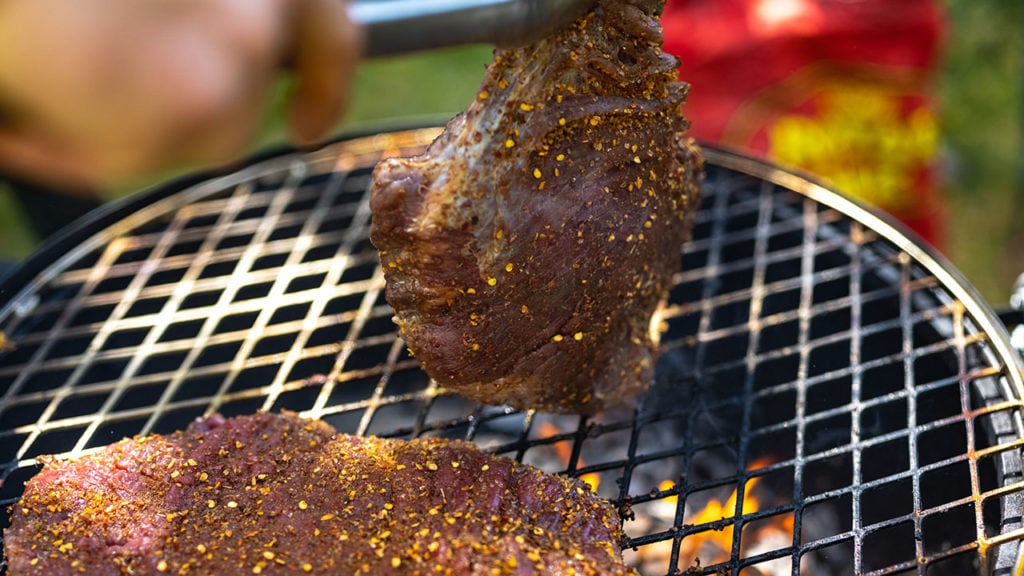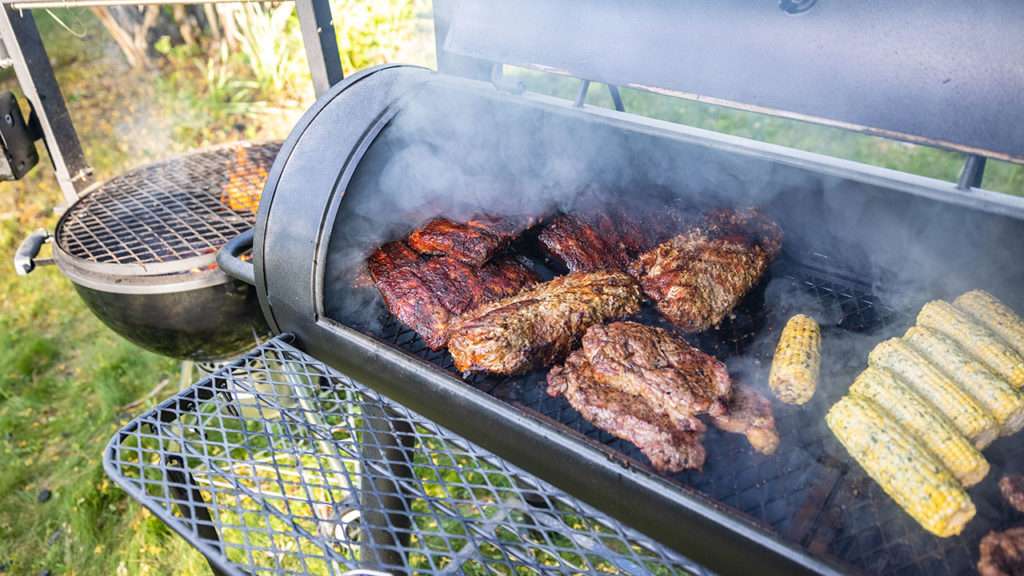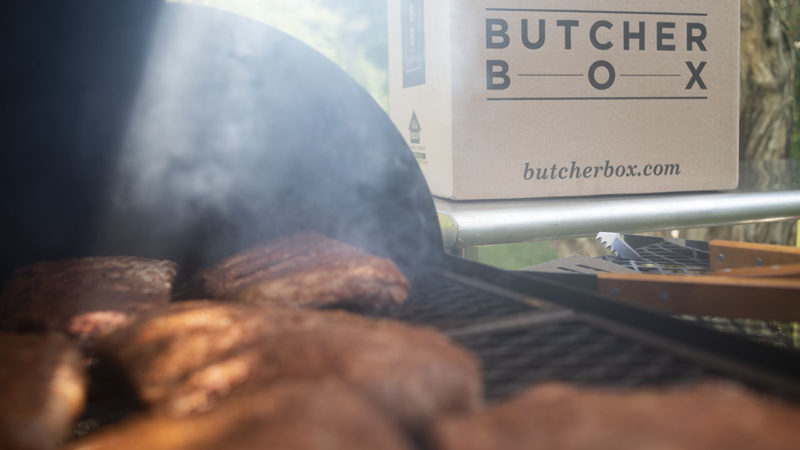Last Updated on May 27, 2022
According to some, we humans may have an innate need to smoke meat.
Whether it is the engaging of our senses—the smell of cooking pork and burning wood, the taste of well-seasoned smoked turkey breast, the feel of sticky rib sauce covering our hands and face—or the stirring of memories of sitting by a cook fire or enjoying the first bites of barbecue, there is a depth to the process of smoking meat that separates it from other cooking techniques.
While smoking meat involves a bit of time and some preparation, it is not as challenging as you may imagine.
Let us take you through the basics to get you on your way to smoking your first brisket or pork butt. Fair warning, you may not get the results you want the first time you attempt to smoke a larger cut of meat, but you’ll get something great to eat and gain experience to help you as you improve your smoking abilities.
Getting the Right Smoker
The first step on your journey to learning to smoke meat properly is to make sure you have the right grill.
Here is our advice:
Start with a kettle grill.
A classic Weber kettle grill will allow you to smoke meat if you set it up correctly. Start with some charcoal and then add in a variety of wood chips as the coals get hot. We’ll get into that process a bit below. But just know, that if you are starting out smoking meat for the first time, you don’t need an expensive smoking-specific grill or homemade smoker.
Work on your technique, then upgrade to an expensive Green Egg, Traeger, or other smoking grills.
How to Balance Heat and Smoke in a Kettle Grill
You have two choices for how to add wood to your hot charcoals:
- You can soak your wood chips beforehand
- Or, use dried wood chips. Experiment with both ways to see which works best for you.
The main thing is that you want to always have enough oxygen to feed the fire so that it keeps the wood hot, but not enough oxygen to that it is on fire.
The best way to do this is to keep the vents on the bottom open a little bit so it can pull some air in and then out through a vent slightly opened on the top.
Figuring out the path of the smoke in the grill is key. You’re going to put the meat in that path between where the oxygen is causing the charcoal and wood to be hot and smoke and where the smoke is exiting the kettle grill.
Here’s the best way to do that:
- Create a small fire in one corner of the grill with your charcoal.
- Throw the wood chips on that hot zone.
- Place the meat opposite the smoking wood
- Slightly open the top vent right above the meat.
Doing this will create an environment inside the grill in which the hot air and smoke is being pulled through the bottom of the meat and out at the top.
How to Keep Your Grill Smoking
A great technique for smoking a large cut for a long time is to have a separate fire going separately that you can use to maintain heat.
If you have a backyard fire pit, that will be ideal for a midday fire or afternoon bonfire.
Add coals to your fire or use burning wood that you can transfer to your grill from time to time. That keeps the fire and wood chips smoking without re-firing and raising the temperature.
Basically, use a separate fire to keep feeding the fire, maintaining a perfect low temperature.
If you add fresh coals to your smoking grill, it will flame up, get really hot, and then take time to burn down again.
The separate fire will provide you with plenty of low-temperature smoking charcoal—wood and coals that are basically almost ready to go out.
Tips for Cooking and Smoking
Thawing and Smoking from Frozen
You can smoke meat from frozen. But we recommend thawing frozen cuts of meat a day or two in advance. This will allow the meat to smoke more evenly.
It will also allow you to add flavor. Just make sure to keep it separate from other food and wrapped to prevent cross-contamination as you thaw.
Flavoring Large Cuts of Meat to Smoke

Thawing frozen meat the day before or overnight also has another advantage. It allows you to build a flavor profile for your meat. This is also key for meat that is fresh and not frozen.
Whether frozen or not, coat the meat with your favorite dry rub, letting flavors build up and get incorporated into the meat. You can experiment with flavors at this point. (Coffee rub? Give it a try. Want some spicy heat? Go nuts.)
Adding a dry rub to the meat you plan to cook a day in advance also helps with the end product. A thoroughly coated cut of pork or beef will develop a really nice crust after smoking it.
Avoiding Flare-Ups When Smoking
One other key to smoking is not allowing any fat drippings from the meat to cause the fire to flare up or worse. Keeping the meat on the other side of the grill from the fire in the path of the smoke will help with that, but, if you have two levels on your grill, putting a catch pan or a tinfoil catch bowl below has multiple benefits.
First, you prevent the aforementioned flare-ups.
Second, you’re going to catch a lot of drippings that you can do amazing things. You can make sauces from the drippings. You can use the fat drippings to cook other things—cornbread, for instance. You can also sauté vegetables and other meats in the drippings which, just have this amazing flavor you can only get through smoking.
Extra Tip: If you are smoking lean meats, putting a foil pan with some water in the bottom or second layer of your grill is going to add some moisture to the environment and that’ll help keep them from drying out.
When Is Your Meat Done Smoking?
Unlike steaks, you aren’t looking for that range of medium-rare to well-done when smoking meat. (Although, you can smoke steaks as well.)
Pork and beef are done smoking once they reach around 145°F and chicken need to reach a minimum of 165°F as checked internally with a food thermometer to be safe. However, for more fall apart meet when smoking, time and low heat is best, so you might want to give to 180°F-200°F.
Once you meet the doneness thresholds of 145°F for pork and beef, and 165°F for chicken, you can experiment with time to see how to get your meat cooked to your liking in that higher doneness range.
Best Meats For Beginners to Cook with a Smoker
Smoking a brisket correctly can certainly become a lifelong pursuit for anyone who gets into smoking meat. But you don’t have to spend hours on end smoking a brisket to learn how to smoke meat. Here are a few cuts to try first.

Top Sirloin Cap/Coulotte/Picanha
Top Sirloin Cap is by far is the easiest cut of beef to smoke, if you are a beginner. It’s already perfect as a medium-rare steak if you just grill it with two zones, so you don’t need to smoke it forever for it to be tender.
You can actually learn a lot about smoking meat and adding that smoking flavor using top sirloin cap Using just the cooler zone of the grill it will cook to medium rare if you give it a little bit longer time than you would if grilling directly on the hotter sections of a grill.
Additionally, the fat cap on this cut really helps protect the meat from overheating. Start with the fat cap facing up and as it cooks and starts to get soft, flip it over for a bit. When it hits the right temperature for doneness, sear the fat-cap-side-down over the smoking hot coals for a couple of minutes.
The results are amazing: Perfectly smoked beef with a crispy, flavorful fat cap.
Tri-Tip
Tri-tip is another cut of beef to use if you are starting out smoking.
Smoking tri-tip is similar, in your approach, to cooking a top sirloin cap. You can smoke it easily on the cooler side of a closed kettle grill or you can grill over coals and wood to get it to medium-rare.
It takes little effort to make a tri-tip delicious. And it doesn’t take all day or all night. Tri-tip is best known cooked the West Coast, Santa Maria-style. Try that approach when smoking this cut.
Ribs
One of my favorite things to smoke is ribs. Ribs are easy.
There are so many different methods to smoking ribs, but the truth is if you put them on a fire, where are you keeping the temperature below 300°F and you give it four or five hours and you brush it with some sauce occasionally, the result is going to be beautifully smoked ribs.
The most common rib smoking method is the 3-2-1 method. You smoke them for three hours, wrap them in tin foil, and smoke for another two hours, then finish by smoking for one final hour with sauce on them. This approach works really well and you are likely to get fall-off-the-bone tender ribs.
Burgers
You can easily smoke burgers in about 10 minutes tops.
Smoking burgers is an ideal entry for beginners trying to learn to smoke meat on a kettle grill. Follow the similar approach to above by cooking in the smoke path of a covered kettle grill like a Weber.
Smoking Fish
I’ll smoke everything, so smoking salmon, which cooks really fast on the grill is a great technique for delicious salmon.
The trick is to first get a nice hot fire on one half the grill. Put dry wood chips on the fire, then place the salmon above. And then close the kettle grill immediately.
If done correctly, the fire becomes basically extinguished. The fire causes a blast of smoke and the grill is already so hot.
Within a matter of minutes, wild-caught salmon will be cooked perfectly and the smell is amazing.
3 Steps to Taking Your Smoking to the Next Level
1. Try a Smoking Box or Pellet Grill
A smoking box is a small cast-iron box with some holes in it that you put some wood chips in. You can put it in one corner of any grill and as the chips heat up they will add smoke to the environment.
If you feel confident and really want to up your game, an intermediate step to take your smoking to the next level is to use a pellet grill to smoke. They are like little wood-burning ovens that have exhausts that help circulate smoke.
You can use pellet grills to cook anything and they range from tiny grills you can use on a table to huge, technology-infused ones.
Both smoking boxes and pellet grills will get you beautifully smoked meat. It’s amazing.
2. Choosing the Right Smoking Woods
Picking the right wood for smoking can also make a big difference, especially with the ending flavor results. Here’s what you should know:
- Hickory and mesquite are going to give you classic barbecue flavors. These are most commonly used and can be found at hardware stores and other places that sell grilling equipment if those woods aren’t native to your area. Hickory logs will create an almost endless amount of smoke for a long period.
- Fruit woods and nut woods are quite amazing for smoking. They’ve got really clean, sweet-smelling smoke. Two to try are cherry and apple woods, which give your meat a little bit of fruitiness.
3. Clean Your Grill
Smoking meat can really muck up a grill and creates lots of ash, so you should make sure to regularly clean your kettle grills or smokers.
Clean surfaces, especially the grates make cooking much easier. And added grease can lead to grease fires.
Make sure to try and clean your grill three or four times a year, especially if you are using it for smoking.
Chef Yankel Polak is a seasoned chef and the Head Chef at ButcherBox, known for his expertise in high-quality meats and bold, flavor-driven cooking. With a passion for teaching and creating approachable yet elevated recipes, he inspires home cooks to master the art of cooking with confidence and creativity.



